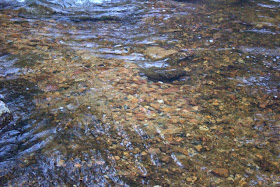This time of year is pivotal for the brown trout populations on the streams that support wild, self-sustaining populations. One of the biggest mistakes that I see made by other anglers is wading through the areas that have been recently spawned. I'm not going to get into the ethics of fishing (or not fishing) for spawners as everyone seems to have pretty strong opinions one way or the other and I'm not interested in starting up that debate on here (but maybe over on the Facebook page for the Trout Zone).
The one thing we should all be able to agree upon is that it is a terrible idea to wade on the redds where the eggs have been recently laid. This past week, on two consecutive days when I had guide trips, I saw people fishing a popular spawning site for the browns in the Great Smoky Mountains. The unfortunate thing about it was that they had waded out on the gravel where the fish have been spawning to get a good cast at some fish they had spotted. If you have very sharp eyes and can spot the redds and wade around them, then I guess we are back to everyone making their own ethical decisions.
The unfortunate reality is that most people have a tough time identifying redds in normal years, and this particular year is anything but that. You see, we had a high water event that bordered on a minor flood only 3 or so weeks ago. It cleaned all of the gravel in the streams of the Smokies to the point that now it is close to impossible to determine where the fish have dug out their nests. That means that wading through a known spawning area (or any gravel area where you have spotted fish holding on or near) is likely resulting in the loss of the next generation.
The best solution? Stay away from the small gravel in the back of pools and in the riffles. If you have spotted a large trout holding in that type of water, it is probably on a nest and should be left alone. Above all, when it spooks 30 feet upstream, don't wade out on the gravel it just vacated to try and cast to it. There were probably eggs there that you are crushing.
Here is an example of a normal redd when high flows have not scoured out the stream recently.
The difference this year is that all the gravel is the same color as the cleaned area in the middle so again, it is nearly impossible to identify redds unless you have a very keen eye. If you must fish the Park during the next 2 months, please at least stay away from gravel areas like this. The really good quality gravel is not in as great a supply as some think and the fish need a good spawn to contribute towards future generations of big wild brown trout.
To wrap up, here are a couple of pictures from a few years ago that will look familiar to those who have been following this blog for a while. These are large spawning brown trout in the Smokies.





Thanks David. As a fisherman who relishes fishing a well known Colorado brown trout water in the Fall, I needed lots of schooling before I was able to spot some of the redds.
ReplyDeleteHoward, they can be tough to see. I can't begin to count the number of spots that I've looked at this year and thought, "That could be a redd but I'm not positive." When in doubt, I always just completely avoid an area...
DeleteLove those pics! Especially the fact that the bottom two both have a different smaller male encroaching on the redd. The one in the last one is surprisingly smaller!
ReplyDeleteThanks! I was fortunate to be there when the fish were so active. It was a golden opportunity for pictures.
Delete